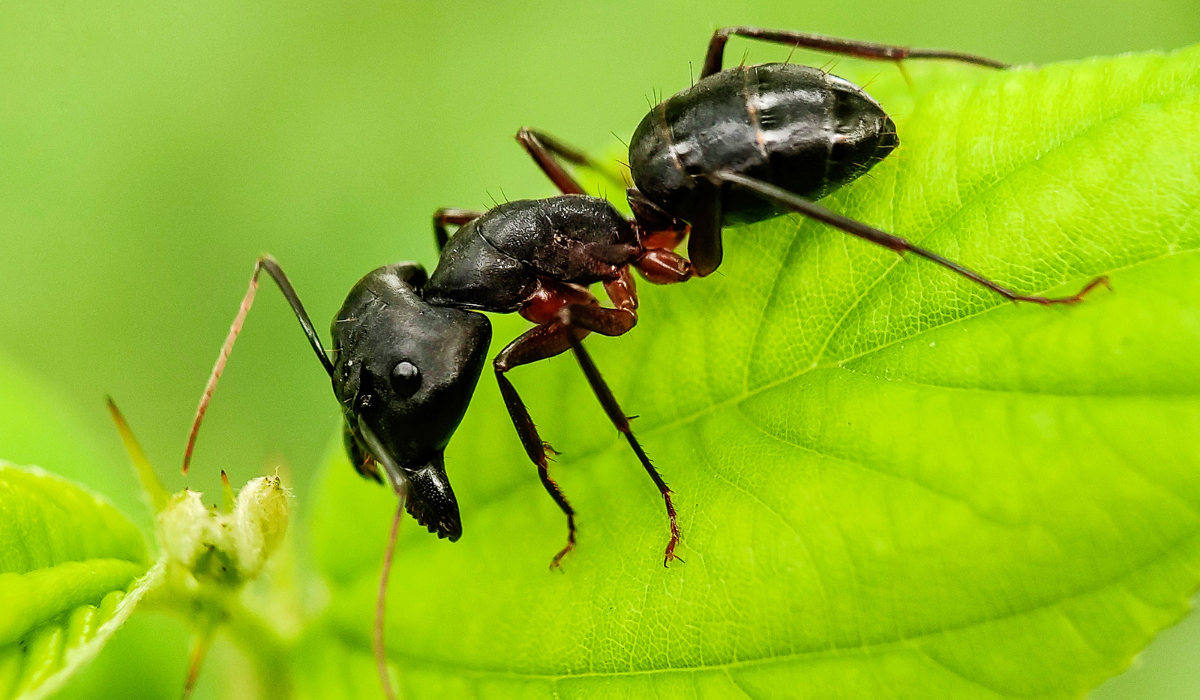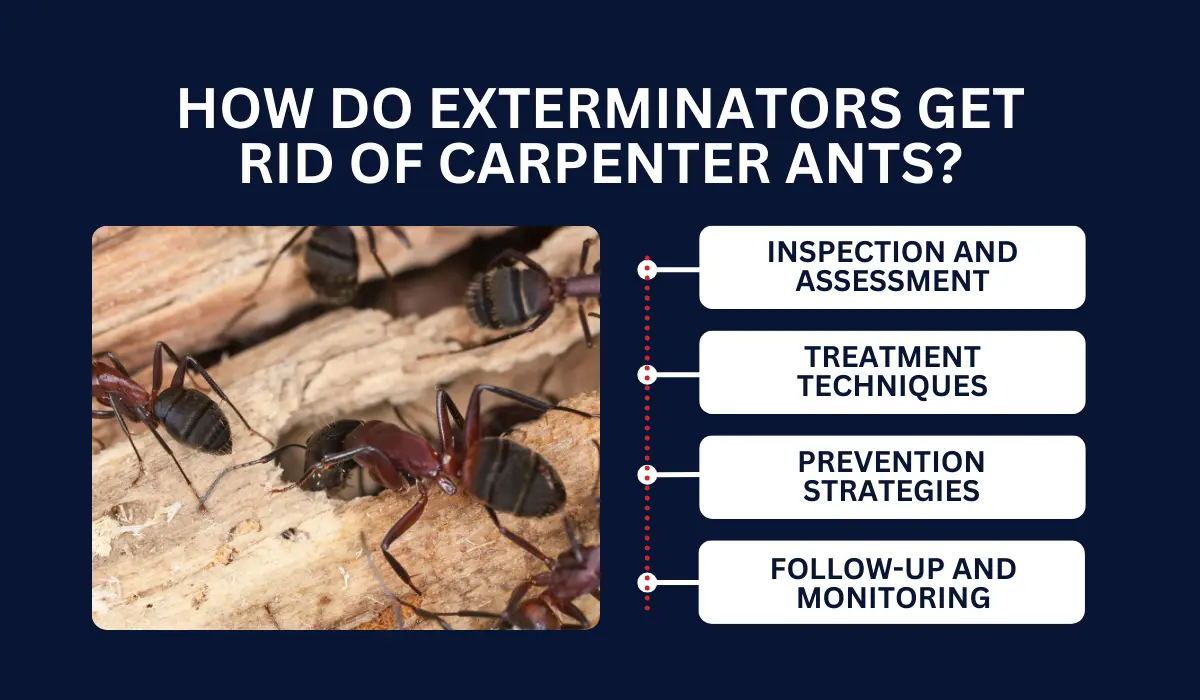
When it comes to dealing with carpenter ants, the complexity of the issue often calls for professional exterminators.
They employ a combination of bait systems, chemical treatments, and physical removal techniques to eliminate these pests effectively.
How do they find and destroy these hidden nests so effectively? Keep reading to learn more about these methods and to ensure your home stays ant-free.
Key Takeaways
- The initial step involves a detailed inspection to identify the carpenter ant species and locate their nests through signs like wood shavings and specific ant trails.
- Treatment methods include applying targeted insecticides and deploying bait systems strategically to eradicate the carpenter ant colonies effectively.
- Prevention involves sealing entry points, controlling moisture, and modifying the habitat to make the environment less inviting for carpenter ants.
- Regular follow-up inspections and long-term control plans are vital to ensure carpenter ants do not return.
- If you notice signs of a severe infestation, such as piles of sawdust or damaged wood, contacting pest control professionals for expert intervention is crucial.

STEP 1. INSPECTION AND ASSESSMENT
A detailed examination helps locate the carpenter ant nest and areas of activity. Several elements are checked during this examination, such as:
- Signs of carpenter ants: Look for wood shavings, sawdust-like material, or frass around wooden structures.
- Carpenter ant trails: Noticeable pathways where ants travel, especially at night.
- Damaged wood: Hollow sounds or grooves in wood indicate nesting.
- Entry points: Cracks and crevices used by carpenter ants to enter buildings.
STEP 2. TREATMENT TECHNIQUES
Exterminators employ multiple methods and repellents to get rid of carpenter ants, targeting specific behaviors and vulnerabilities of the ants to ensure effective elimination.
Targeted Insecticide Application
Insecticides are a primary tool for exterminators. They are designed to kill carpenter ants on contact or after being carried back to the nest.
To proceed, professionals follow detailed steps:
- Choosing the Right Insecticide: Exterminators select pesticide products containing boric acid, deltamethrin, or cyfluthrin formulated for carpenter ants.
- Application Methods: Chemical treatments can be applied as liquids, aerosols, or dust.
- Strategic Placement: Target entry points, trails, and colony locations, including wall voids and crevices.
- Follow-Up Treatments: Depending on the infestation level, additional applications may be needed.
Baiting Systems
Baiting involves using specialized products that attract carpenter ants. This allows them to carry poison from food sources back to their nest, disrupting the entire colony.
Exterminators typically use these proven techniques:
| Techniques | Details |
|---|---|
| Selecting Effective Baits | Options include borax or gel-based baits containing fipronil or imidacloprid. |
| Placement | Carpenter ant baits are placed along pheromone trails. These locations ensure worker ants transport the poison back to the queen and larvae. |
| Patience and Monitoring | The bait needs time to work as ants eat them, often weeks to months for full effect. Regular monitoring and bait replacement are crucial for success. |
Nest Removal
Removing carpenter ant nests is essential for severe infestations. It targets the core of the colony directly, leading to quicker resolution.
Critical steps involved in nest removal include:
- Identification: Locating the main nest and any satellite colonies in walls, attics, or outdoor wooden structures.
- Access: Exterminators may need to drill holes or remove sections of the structure to access hidden nests.
- Extraction: Physically removing the nest material and remaining ants.
- Follow-Up: An insecticide application at the site is needed to eradicate stragglers and prevent re-infestation.
STEP 3. PREVENTION STRATEGIES
Preventing carpenter ants from returning is a shared responsibility. As homeowners, you play a crucial role in maintaining a pest-free home.
By employing the prevention strategies taught by exterminators, you can ensure that your home remains unappealing to these pests.
Exclusion Techniques
Exclusion involves making it difficult for carpenter ants to get inside. As part of carpenter ant control, you will be taught to:
| Exclusion Techniques | Description |
|---|---|
| Seal Cracks | Use caulk to seal gaps in crevices, walls, windows, and doors. |
| Repair Damaged Wood | Replace or fix damaged wood promptly to eliminate entry points. |
| Screen Vents and Openings | Ensure that vents, chimneys, and other openings are covered with screens. |
| Trim Tree Branches | Keep tree branches from touching the house. |
Moisture Control
Carpenter ants are attracted to moist environments and often nest in damp, decaying wood. As a result, moisture control becomes crucial.
Exterminators can teach you how to do these strategies properly:
- Fix Leaks: Repair leaking pipes, faucets, and roofs to eliminate moisture sources.
- Use Dehumidifiers: Maintain indoor humidity levels below 50% with dehumidifiers.
- Ventilation: Ensure proper ventilation in areas like attics and crawl spaces.
- Inspect and Repair: Regularly check areas prone to moisture, such as basements, and repair any water damage.
Home Maintenance
Changing the environment around the house can deter carpenter ants by removing potential nesting sites.
Ask your exterminators how to manage the outdoor and other structures properly using these techniques:
| Modifications | Description |
|---|---|
| Remove Wood Piles | Store firewood and wood debris away from the home. |
| Landscaping Maintenance | Keep mulch, plants, and debris away from the foundation. |
| Pet Food | Store pet food in airtight containers to avoid attracting ants. |
| Regular Inspection | Inspect tree stumps and other wooden structures for signs of carpenter ant activity. |
STEP 4. FOLLOW-UP AND MONITORING
After the initial extermination process, it’s crucial to ensure that the carpenter ants don’t return.
Inspection Schedule
Scheduled re-inspection visits by a pest control professional can catch missed carpenter ant colonies or returning ants before they cause serious damage.
To maintain vigilance:
- Monthly Inspections: A pest control expert may begin with monthly checks for signs of carpenter ant infestations.
- Quarterly Check-Ups: Once the situation stabilizes, inspections can be reduced to every three months.
- Critical Areas: Crucial places like window sills, baseboards, and around stumps should be re-inspected. These are common areas where parent colonies or satellite nests might settle.
Long-Term Control Plans
Developing a long-term control plan ensures that carpenter ant problems don’t return. Critical components of a long-term plan to prevent structural damage include:
| Long-Term Control Plans | Details |
|---|---|
| Preventive Treatments | Regularly apply natural remedies or commercial treatments around vulnerable areas like door frames and window sills. |
| Environmental Adjustments | Removing wood debris, sawdust, or stumps to reduce potential nesting sites. |
| Continuous Monitoring | Monitor moisture levels, especially in basements and attics. Excess moisture can attract ants. |
IS IT TIME TO CALL THE EXPERTS?
If the infestation seems minor, you might try DIY pest control solutions like diatomaceous earth. However, if you notice sawdust piles, faint rustling noises in walls, or damaged wood structures, it might be time to call for pest control help.
Whether you’re in Baton Rouge, Plaquemines, or New Orleans, seeking expert help should be easy. For immediate intervention for a severe infestation, let Lajaunie’s ant control specialists tailor a solution that’s right for your home.
For more information about the areas we service, visit our location page.